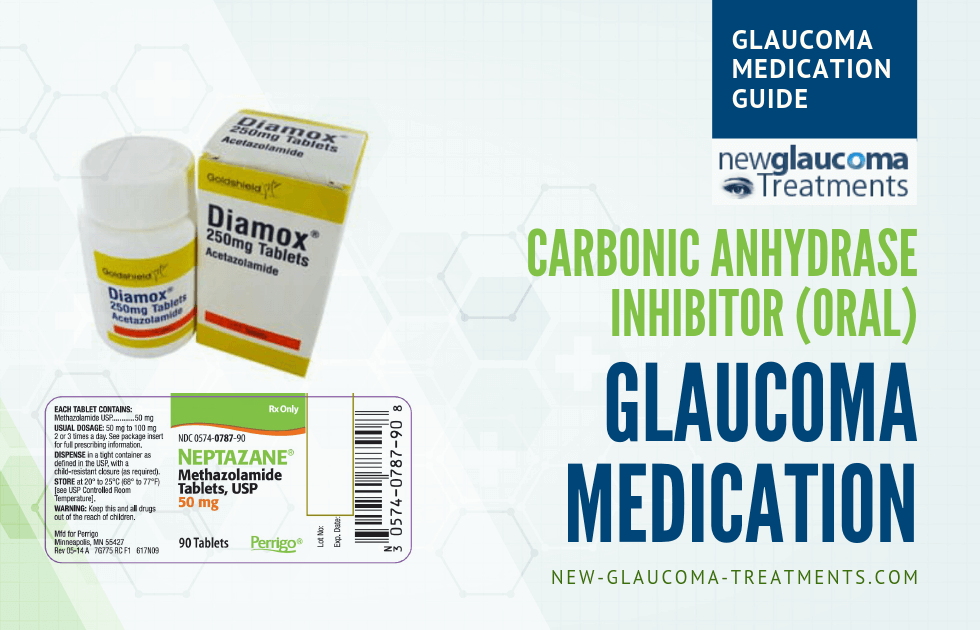A Patient’s Guide to Glaucoma Medications

Carbonic Anhydrase Inhibitors (CAIs) Oral Medication for Glaucoma
Carbonic Anhydrase Inhibitors (CAIs) have been used to lower intraocular pressure (IOP) for over 70 years.
How this class works:
Works on the ciliary body to reduce production of aqueous fluid[1].
How well does it work:
Acetazolamide: Really well. This is the most effective IOP lowering medication that is available for prescription outside of a hospital setting.
Methazolamide: Not so much
Commonly prescribed:
How it is taken:
By mouth. Two to four times daily.
When might these be prescribed?
Generally reserved for use around surgery or with dangerously elevated IOP not controlled with topical medications.
Cost?
Given that this medication has been FDA approved for decades you’d think it would be cheap, right? And a few years ago you would have been right. For reasons I cannot explain, however, the oral CAIs are now quite expensive.
If you are prescribed this medication and it is not covered by your insurance or even with insurance coverage it’s quite expensive then I recommend you search out a good cash price through the website “GoodRx”. I frequently recommend this site to my patients and have been surprised at how much they can often save on certain classes of medications despite not using their insurance.
Side effects[2]:
- Transient induced myopia (nearsightedness)[3]
- Angle closure
- Need to urinate more frequently
- Tingling of fingers
- Gastrointestinal upset
- Nausea, cramps, diarrhea
- Fatigue, lethargy, depression, decreased libido[4]
- Metalic taste (especially with carbonated beverages)
- Kidney stones[5]
- Rare but life-threatening:
How to minimize side effects:
- GI side effects (take with meals)
- Hypokalemia (potassium supplementation)
- Kidney stones (need to maintain adequate hydration)
- Aplastic anemia: can’t avoid but can monitor for symptoms of anemia
Interactions with other medications:
- Should not be used with:
- Thiazide diuretics
- Digitalis
- Use with caution in those with allergy to sulfa-containing drugs
Summary:
One of the most effective medications for lowering IOP is, unfortunately, one of the least well tolerated. As such, the oral CAIs are generally reserved for those who have dangerously elevated IOP not controlled with topical medications.
References:
[1] Wistrand PJ. Carbonic anhydrase inhibition in ophthalmology: carbonic anhydrases in cornea, lens, retina, and lacrimal gland. EXS. 2000;90:413-424.
[2] Lichter PR. Reducing side effects of carbonic anhydrase inhibitors. Ophthalmology. 1981;88(3):266–269.
[3] Bovino JA, Marcus DF. The mechanism of transient myopia induced by sulfonamide therapy. Am J Ophthalmol. 1982;94(1):99–102.
[4] Wallace TR, Fraunfelder FT, Petursson GJ, et al. Decreased libido: a side effect of carbonic anhydrase inhibitor. Ann Ophthalmol. 1979;11(10):1563–1566.
[5] Kass MA, Kolker AE, Gordon M, et al. Acetazolamide and urolithiasis. Ophthalmology. 1981;88(3):261–265.
Ellis PP. Urinary calculi with methazolamide therapy. Doc Ophthalmol. 1973;34(1):137–142.
[6] Spaeth GL. Potassium, acetazolamide, and intraocular pressure. Arch Ophthalmol. 1967;78(5):578–582.
[7] Flach AJ, Smith RE, Fraunfelder FT. Stevens-Johnson syndrome associated with methazolamide treatment reported in two Japanese-American women. Ophthalmology. 1995;102(11):1677–1680.
[8] Fraundfelder FT, Meyer SM, Bagby GC Jr, et al. Hematologic reactions to carbonic anhydrase inhibitors. Am J Ophthalmol. 1985;100(1):79–8
Related Articles:
- Medical Therapy for Glaucoma: Alpha-Agonists
- Medical Therapy for Glaucoma: Beta-blockers
- PolyActiva Commences Clinical Trial of Biodegradable Ocular Implant for Glaucoma
- VYZULTA™: A New FDA Approved Glaucoma Medication with Dual Action
- Sustained Drug Delivery for Glaucoma Treatment – An Update from the American Glaucoma Society (AGS) 2017 Annual Meeting

David Richardson, MD
Medical Director, San Marino Eye
David Richardson, M.D. is recognized as one of the top cataract and glaucoma surgeons in the US and is among an elite group of glaucoma surgeons in the country performing the highly specialized canaloplasty procedure. Morever, Dr. Richardson is one of only a few surgeons in the greater Los Angeles area that performs MicroPulse P3™ "Cyclophotocoagulation" (MP3) glaucoma laser surgery. Dr. Richardson graduated Magna Cum Laude from the University of Southern California and earned his Medical Degree from Harvard Medical School. He completed his ophthalmology residency at the LAC+USC Medical Center/ Doheny Eye Institute. Dr. Richardson is also an Ambassador of Glaucoma Research Foundation.


